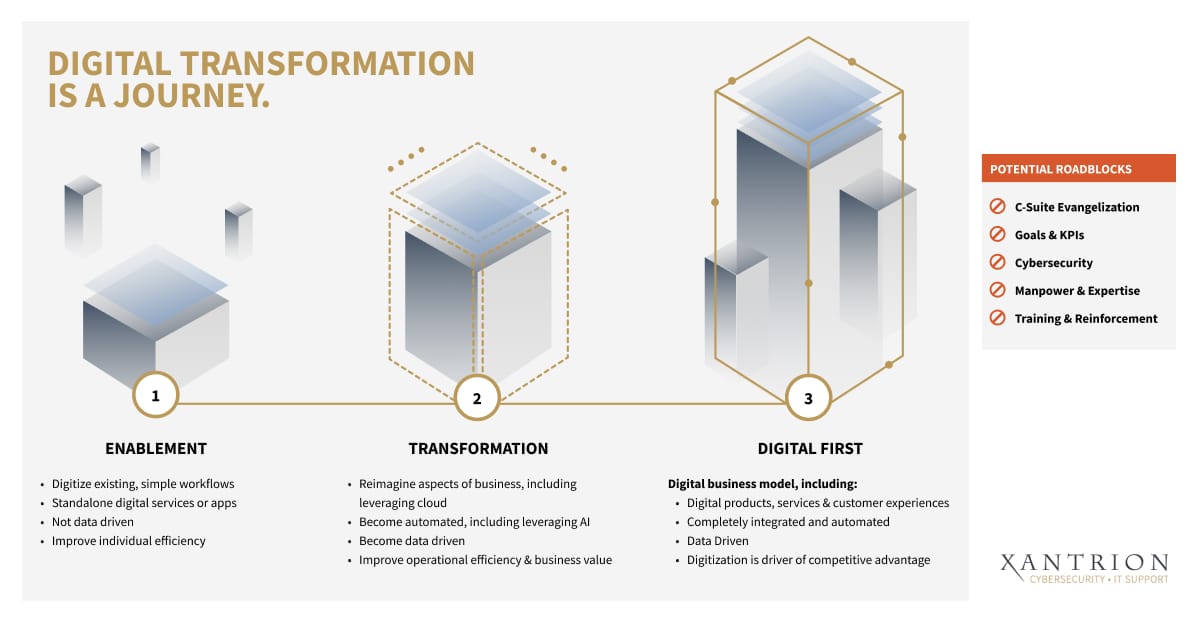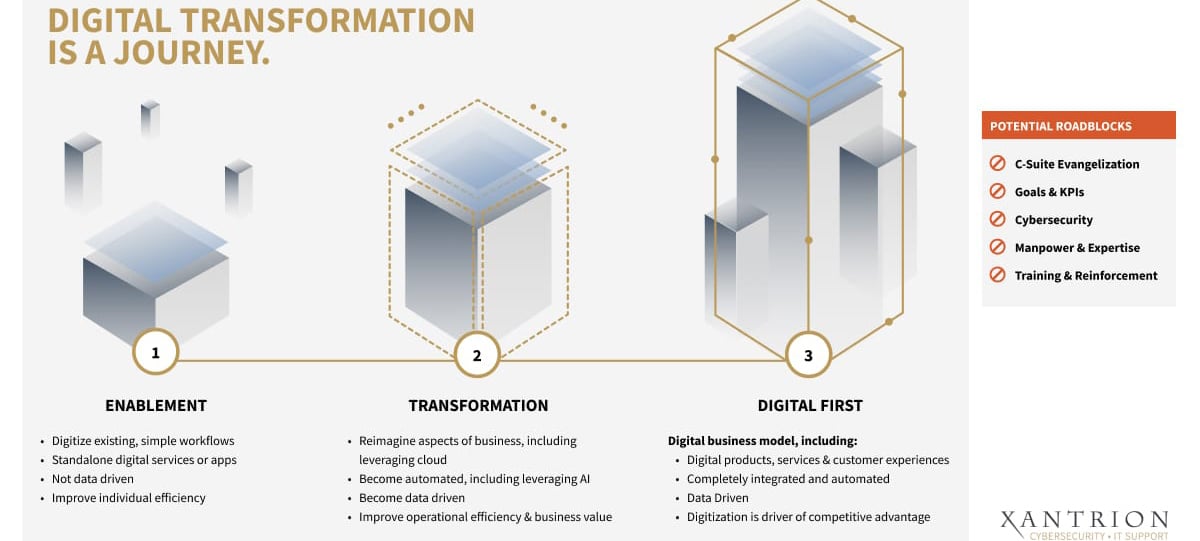For growing businesses, digital transformation is exciting, necessary…and sometimes challenging to understand. One way to imagine your digital transformation journey is to consider it in three stages: enablement, transformation and digital first.
The infographic below, created by experts from Engine Room, Xantrion and the 2Go Advisory Group, delineates the typical journey in greater detail.

What’s the connection between digital transformation and AI?
We believe that if you want to improve efficiency and profitability, provide better customer and employee experiences, and build a platform for growth, a deliberate approach to digital transformation is critical to your success. This is true whether that transformation revolves around AI or relies on other tools.
We view AI as a tool in the digital transformation toolbox because digital transformation is the use of technology to change how a company operates and delivers value to its stakeholders. Such technology typically consists of software and cloud services, some of which include AI.
What does the enablement stage look like?
To understand the enablement stage of digital transformation, it may be helpful to look at a real-world example: a life sciences startup seeking to improve internal controls and efficiency in how they pay suppliers.
At the outset, the company relied largely on a cumbersome manual process that included employees’ approving vendor invoices before sending them on to accounting. Then, the accounting department would either write checks or use their bank’s bill pay tool to pay vendors. Too often, this process delayed payments and put the young company at risk of fraud.
To streamline the process, the company implemented Bill.com, which allows vendors to enter their invoice information directly and leverages AI to ensure the information is accurate. The invoice is then automatically routed for approval to the appropriate parties, a process also enhanced by AI. After approval, vendors can be paid quickly through an ACH wire transfer.
With the new system in place, bills were paid faster, the likelihood of errors or fraud was reduced, and employees were happier to have a smoother, less labor-intensive payment process. Such processes can be made secure with measures such as multifactor authentication, identity monitoring and role-based access and permissions, which can help ensure the right people are involved each step of the way.
What does the transformation stage look like?
As with enablement, reviewing a real-world example can help businesses understand the digital transformation journey. One company that recently embarked on the transformation stage was a biotech business preparing to shift its focus from product development to manufacturing and sales.
In this case, the company’s journey was both a cautionary tale and success story. Executives wanted a fully integrated digital infrastructure to support their new business model and to achieve efficiency. However, they chose to implement customer relationship management (CRM) software without following best practices: having an experienced team in place before undergoing system selection and design. As a result, company leaders later abandoned the first CRM software in favor of different CRM software. The dearth of planning and about-face on software ultimately cost the company both time and money.
The business later righted the ship by hiring and engaging the right in-house team and consultants, undertaking process then system design, and finally, implementing an integrated system, from ordering to manufacturing to shipping. The system consisted of NetSuite modules for finance and accounting, inventory management and more. NetSuite includes AI capabilities, such as data-driven insights that inform decisions on ordering raw materials. It also meets cybersecurity requirements, such as systems availability as well as data portability, ownership and backups. Today, as the company progresses in its digital transformation and explores other tech-powered capabilities, it’s well on its way to the third stage: becoming digital first.
What should you consider as you investigate AI?
In the cases we explored, AI played a role in digital transformation. However, its role was additive, rather than central. The reality is that currently, there may be greater ROI for non-AI tools.
When you are specifically investigating AI, we believe you will do well to consider the following:
- Use public tools, like ChatGPT, with caution and implement policies to prevent sensitive information from being uploaded to public tools.
- Be patient while AI is rapidly evolving, lest you implement a solution that becomes obsolete in three to six months.
- Be aware that non-AI tools can position you to leverage AI in the future because they can help you develop the culture, security mindset, and expertise required to implement ANY new technology.
How can you jump-start your transformation without wasting your time and money?
When it comes to digital transformation, especially transformations involving AI, it’s tempting to gravitate toward the “shiniest” new tool. However, we recommend starting with measured steps rather than giant leaps. Try experimenting with the AI features in the software you already own, such as Salesforce and Bill.com. Also consider having a few executives use simple AI tools, like CoPilot, to expand their understanding of AI, what value it can bring and how it’s evolving.
Before you begin incorporating AI into your workflows, we recommend answering the following questions:
- What problem(s) are we trying to solve, or what goals are we trying to achieve with our digital transformation?
- How will we understand the impact of our initiatives? What metrics will we use to measure our progress and what milestones will we strive for?
- What people power, skill sets, business process expertise, communication practices and financial resources are required?
- What software and cloud services are the best for the problem we have defined? Do solution options meet my cybersecurity, systems availability, data ownership, data portability and compliance requirements?
- What training and change management tools will accelerate our transformation and improve our ROI?
- What kind of data categorization, protection and role-based access is required to minimize the cybersecurity risk of my transformation initiatives?
If you are looking for experienced partners to help you develop an AI or digital transformation plan tailored to your business, contact Mike at mrose@engineroom.com for finance and accounting, Christian at ckelly@xantrion.com for cybersecurity or Seth at seth@2goadvisorgroup.com for more general operations advice.
By Mike Rose, CEO, Engine Room, Christian Kelly, CTO, Xantrion, and Seth Tuman, COO, 2Go Advisory Group

